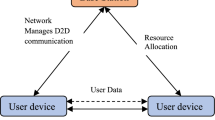Abstract
The 3rd Generation Partnership Project (3GPP) has recently developed device-to-device (D2D) communication to cope with the explosively increasing mobile data traffic. The D2D communication uses sidelink that is based on the single-carrier frequency-division multiple access scheme because of its low peak-to-average power ratio. In addition, the demodulation reference signal is designed to support multiple input multiple output. In this paper, we propose a DFT-based channel estimation scheme for sidelink in D2D communication. The proposed scheme uses the two-dimensional minimum mean square error interpolation scheme for a user moving at a high speed. We performed a system level simulation based on 20-MHz bandwidth of the 3GPP LTE-Advanced system. Simulation results show that the proposed channel estimation scheme has improved signal-to-interference-plus-noise ratio, throughput, and spectral efficiency as compared with a conventional scheme.












Similar content being viewed by others
References
Zulhasnine, M., Huang, C., & Srinivasan, A. (2010). Efficient resource allocation for device-to-device communication underlaying LTE network. In IEEE 6th WiMob.
Wang, H., & Chu, X. (2012). Distance-constrained resource-sharing criteria for device-to-device communications underlaying cellular networks. IET Electronics Letters, 48(9), 528–530.
Xing, H., & Hakola, S. (2010). The investigation of power control schemes for a device-to-device communication integrated into OFDMA cellular system. In 2010 IEEE 21st international symposium on personal indoor and mobile radio communications (PIMRC), 1775–1780.
Min, H., Seo, W., Lee, J., Park, S., & Hong, D. (2011). Reliability improvement using receive mode selection in the device-to-device uplink period underlaying cellular networks. IEEE Transactions on Wireless Communications, 10(2), 413–418.
Samsung. (2012). Standard trends and performance analysis of cooperative communication on a point-to-point transmission based on LTE-A. TTA Journal, 139, 94–99.
Myung, H. G., Lim, J., & Goodman, D. J. (2006). Single carrier FDMA for uplink wireless transmission. IEEE Vehicular Technology Magazine, 1(3), 30–38.
3GPP TS 36.211. (2013). Evolved universal terrestrial radio access (E-UTRA); physical channels and modulation, V11.4.0.
Zaka, K., Ali, A. Y., Anis, M. I., Zaman, S., Usmani, I., & Ahmed, N. (2009). Technique for channel estimation in OFDM transmission system using linear interpolation and Euclidean distance algorithm. In Asian Himalayas international conference on internet (AH–ICI) 2009, pp. 1–5.
3GPP TR 36.866. (2014). Study on network-assisted interference cancellation and suppression (NAICS) for LTE, V12.0.1.
R4-131291. (2013). Discussion on reference IC/IS receivers for NAICS, Chicago, IL, US, 15–19 April.
Hanzaz, Z., & Schotten, H. D. (2013). Analysis of effective SINR mapping models for MIMO OFDM in LTE system. In 2013 9th international wireless communications and mobile computing conference (IWCMC), 1–5 July 2013.
IST-2000-30116 FITNESS Project. MTMR baseband transceivers needs fur intra-system and inter-system (UMTS/WLAN) reconfigurability, Deliverable D3.3.1.
3GPP TR 25.892. Feasibility study for OFDM for UTRAN enhancement (release 6). v1.1.0, (2004-03).
Ericsson. (2003). Effective SNR mapping for modelling frame error rates in multiple-state channels. 3GPP2-C30-20030429-010.
Cheng, J. F. T. (2004). Coding performance of various type-I HARQ schemes with BICM. In Proceedings of ISIT 2004.
IEEE 802.11-04/0269. (2004). PHY abstraction based on PER prediction.
3GPP TR 36.814. Further advancements for E-UTRA physical layer aspects (Release 9), V9.0.0 (2010-03).
Acknowledgements
This work was supported by the ICT R&D program of MSIP/IITP. (14-000-04-001, Development of 5G Mobile Communication Technologies for Hyper-connected Smart Services). This work was supported by the Human Resource Training Program for Regional Innovation and Creativity through the Ministry of Education and National Research Foundation of Korea (NRF-2014H1C1A1066568).
Author information
Authors and Affiliations
Corresponding author
Rights and permissions
About this article
Cite this article
Moon, S., Choe, H., Chu, M. et al. DFT-Based Channel Estimation Scheme for Sidelink in D2D Communication. Wireless Pers Commun 97, 1197–1215 (2017). https://doi.org/10.1007/s11277-017-4561-0
Published:
Issue Date:
DOI: https://doi.org/10.1007/s11277-017-4561-0




